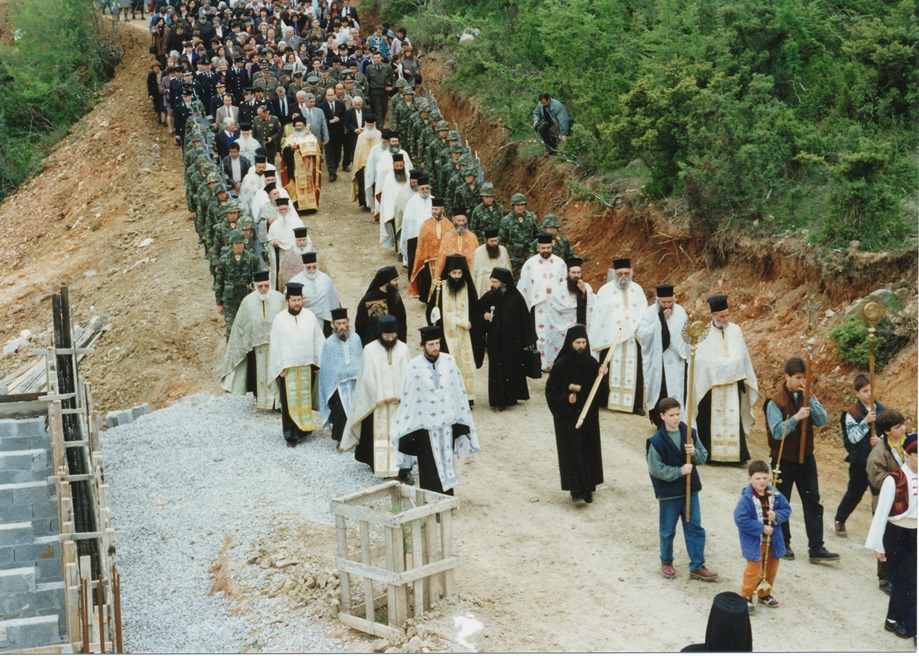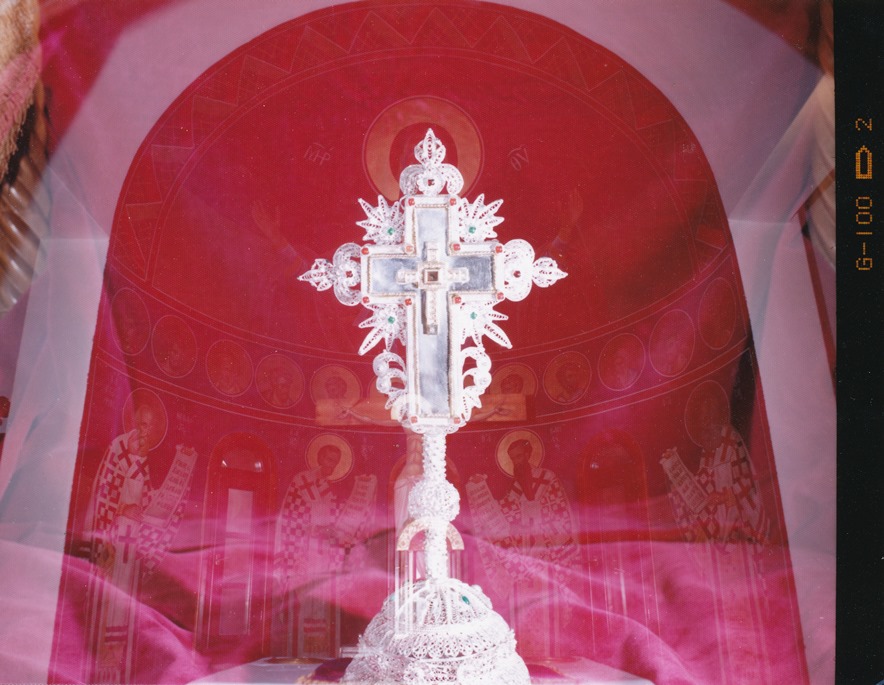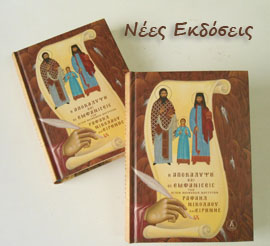Our liturgical life
Although we have already mentioned some things earlier, the inner life of the Monastery is not recorded in a book or a website. Its path is not enclosed in a few pages and some important events, such as those previously stated or those that we will mention below.
The "inner" life of every brother and consequently of the Brotherhood "has been kept hidden" from any publicity. It is the giving of the soul, the giving of every minute of the every day life to the Lord. It has been kept in obscurity because it is dedicated to God. The only one who knows it is "the terrible eye” of the inexpressible love of our Christ. For His mercy we strive to resort every day and constantly, as is the due of every single believer as well.
As a Monastery, we have to radiate this message essentially in secret. This happens because we belong to the Body of the local Church, the Body of Christ, affecting and being affected by spirituality or not of the other members. We do not know if we, thanks to His mercy, manage to contribute something, praying, working, proffering a discourse of spiritual rigour, touring our pilgrims and particularly stressing the importance of the disclosure of the Saints in our time.
Each day, the arranged Liturgies are held by the entire Brotherhood (Midnight, Matins, Hours, Vespers, and Compline) with the focus or the highlight resting in the Mass at the Chapel of the Myrrhbearer Saints. This is our most important task, as is the case in all other Monasteries; heaven on earth and earth to heaven through the divine worship "for the sake of the life and the saving of the world." Once a week we operate at Saint Basil’s Chapel. Each Sunday we hold service on the main Temple, which is dedicated to the three Saints and is always crowded with pious pilgrims who are friends of the Martyrs.
Every afternoon after Vespers, we perform the Plead to our Saints for the salvation of the souls and the bodies of our Brotherhood and of the pilgrims, especially for those who are sick and those experiencing problems and resort to the mediation of the saints to our Christ. On the first Sunday of each month after Vespers we perform the Sacrament of Unction, again for the same holy cause, as we are encouraged to do so by the Apostle Saint James, brother of the Lord.
In particular, our Monastery has established the performance of the following Wakes as well: on June 22nd to 23rd for the anniversary of the discovery of the relics of Saint Raphael (in 1959 in Lesvos); on July 21st to 22nd for the memory of the holy Myrrhbearer, Equal to the Apostles and fine virgin Mary Magdalene; on August 1st to 2nd on the anniversary of finding the relief amulet icon of the Almighty (in 1961 in Lesvos); November 24th to 25th in memory of the Holy Martyr Catherine.
Moreover, we also hold special honours to the memories of the Apostles Andrew, Peter and Paul (at the Chapels of the central Temple), Saint Basil the Great, the Myrrhbearer Saints (on the Sunday of the Myrrhbearers in the namesake Chapel).
The feast of Bright Tuesday (Lamprotriti)
The top festival is, however, that of “Lamprotriti”, the Tuesday after Easter, on Easter week with the Grace of our patron saints. Lamprotriti was the day the martyred ending of St. Raphael. The Turkish invaders first began to torture him on Good Friday. They tortured him for 24 hours and on Great Saturday, they hung him upside down from a walnut tree and sawed off his mouth, severing the lower jaw. It was April 9 of 1463. He did not die there, because they did not hurt his carotids, as he revealed in a dream to Mary Tsolakis in 1988. He survived with terrible pain, while watching the tortures all his fellow martyrs. In this lasting torment, he lived until the evening, at a quarter to midnight, before the dawn of Lamprotriti when he was eventually beheaded. It was then April 12. The day of his own martyrdom, after revealed nowadays, is celebrated as a day of remembrance, honor, praise, hymns. On this day we honor the three emergent Saints, also remembering and bearing witness to others. Such day we glorify our Christ, who called them in such honor to endure the torture of His love as He endured the cross and death for our love and the salvation of the whole world.
During, that weekend thousands of families of believers literally invade the Temple and the yard, "from early morning until night." They are hanging, so to speak, by the God-given Grace of the miraculous novel saints. The icon of the Saints with innumerable valuable offerings by all kinds of those benefitted stands as a silent but fervent preacher of so many miracles.
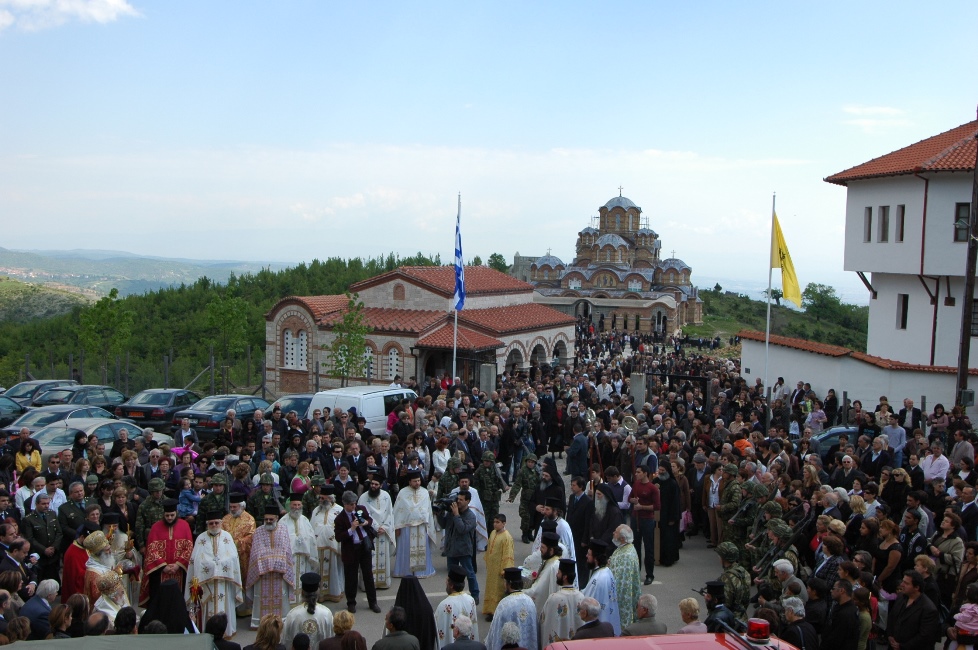
After the end of the Holy Mass, the reliquary with the holy relics of three Saints and the icon with the tributes (held by Priests) is transferred in procession as well as the special reliquaries with the part of the skull of the Saint on top of the right eyebrow and with a half-burnt rib of virgin Martyr Irene (which are upheld by the two Hierarchs who use them in order to bless the people).
The procession is one other liturgical practice of our Church. It shows in a quite vivid manner that the Saints are in charge and we follow. They are our living examples in the way of Christ's love, and we are trying to walk on their own traces. They are our elder brothers, as His Eminence frequently calls them, who help us turn ecclesiastically mature, to mature our faith, our worship, the offering of ourselves to Christ.
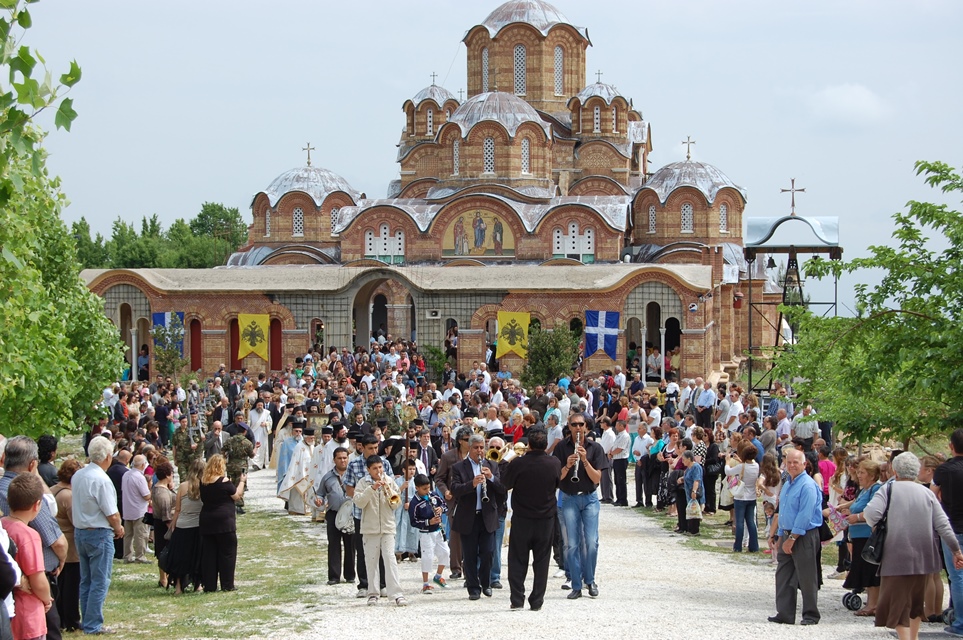
Saint Raphael’s holy relics
The permanent spiritual treasure of the Monastery consists in fragments of the grace-given relics of the newly revealed Martyrs Raphael, Nicholas and Irene, which are kept in an elegant reliquary and are permanently exposed to daily worship. A holy relic of Saint Raphael is located within the holy icon as well. After the altar (the heart of the Monastery), it is the holy martyr relics of our Saints (the lungs of the Monastery) supply us with the 'oxygen' of the example, of patience, of sacrifice, of the resurrected being, of the graces and of the miracles of our Saints.
All the relics of the newly revealed Saints and the sacred heirlooms were discovered during the years 1959-1962. In September 1962, Saint Raphael’ Monastery at Lesvos was founded, and in 1964 the first two Nuns settled there in permanent settlements, the Abbess Eugenia and the nun Parthenia (both of them now late). These first two Nuns received the holy relics by the peasants who were the ones to have seen the Saints, to undertake the excavations, and to have found and honoured for so many years.
In the early period, up until the female monastic sisterhood in Lesvos was organized, certain persons, either formally or informally, had received a part of the holy relics thanks to a personal blessing. These were the late Metropolitans Iakovos Kleomvrotos of Mytilene and Iakovos Malliaros of Mithimna (who inaugurated the temple of the Saint), the late novice nun Vasiliki Malliarou, the subsequently Athonite monk Emmanuel Malliaros (formerly a monk at Nea Skiti, later nursed at Saint Gregory’s Holy Monastery) and the unforgettable grand benefactor of the Holy Monastery of Lesvos Irene Paradelli.
Hence, so far, aside from the nunnery of Lesvos, several parts of the holy relics of the three Saints are held by the historical Monastery Leimon Lesvos (which inherited the vestry of Metropolitan Iakovos of Mithimna), the Abbot of the Saint Nicholas Holy Monastery of Andros (by the late Irene Paradelli and the nun Vasiliki Malliarou), Father Emmanuel Malliaros (thanks to an offer by Metropolitan Iakovos of Mithimna) and the Vicar of the Holy Church of Saint Athanasius Mytilene, father Efstratios Anastasellis (heir of the rest of the vestry Irene Paradellis). Other persons may hold pieces of the relics as well.
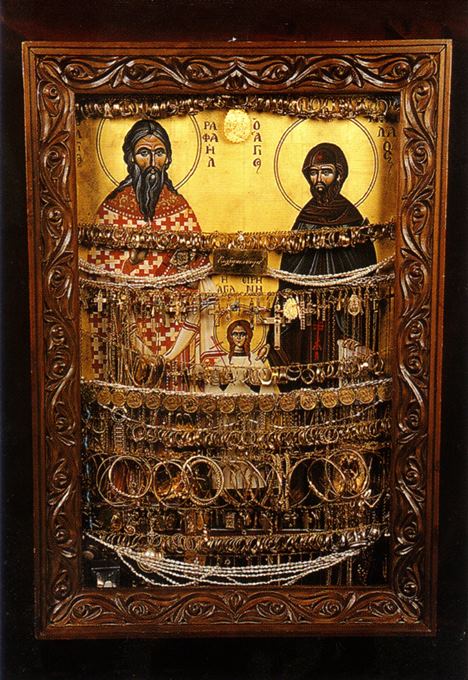
The sections relics held by his Eminence our Metropolitan and our Elder out of the four sources above, according to official, signed, sealed documents existing both in the Archive of our Monastery and in Griva. Pieces of them have been delivered to us in a refined silver reliquary with enamel performances as a permanent blessing of the Monastery.
In his confirmation, the Abbot of the Holy Monastery of Leimon of Lesvos Archimandrite Nicodemus Pavlopoulos writes "on July 22nd of AD 1984, according to the wish of the late Metropolitan Iakovos of Mithimna, we have delivered out of His sacristan of our Monastery His pieces of the holy Relics of the novel Martyrs of Thermi Saint Raphael and of the notable Vasileios with the fragment of the jar in which the Agarenes burned the body of the holy virgin Irene...".
Moreover, the Abbot of Saint Nicholas’ Holy Monastery of Andros, the Archimandrite Dorotheos Themelis states: "we have donated to his Holiness the Archimandrite Father Demetrius Bekiaris, Abbot of the Holy Monastery of Petrakis and Chancellor of the Holy Archdiocese of Athens, pieces of the holy relics of the newly revealed saint Martyrs, the miraculous Saint Raphael, ascetic in Thermi of Lesvos, and of his fellow ascetic and disciple deacon Saint Nicholas for pilgrimage by the believers and for the healing of patients. These come from the lady of Lesvos, the memorable Irene Paradelli, who had been the principal sponsor of the performed excavations of the finding of the holy relics ...".
Likewise, the Athonite monk Emmanuel Malliaros reported to an official correspondent from the cell of Saint Anargyroi of. Nea Skiti in Athos: "Through this, I certify that indeed, out of my personal sacristan I have offered to You four (4) pieces of the holy relics of the Martyrs Raphael, Nicholas and Irene, for the glory and honour and the pilgrimage of the grace living inside them of the Holy Spirit. These things have come to me through the late Metropolitan of Mytilene Iakovos Kleomvrotos...".
Additionally, Fr. Efstratios Anastasellis, Chaplain of Mytilene also states on his certificates: "... I have delivered to his Holiness the Archimandrite Demetrius Bekiaris ... on July 20th 1986 sections of the Holy Relics of the Saints Raphael, Olympia Irene and the holy Martyr Helen out of the shrine of the late Irene Paradelli that have come to me through an inheritance". And "... parts of the holy relics of: Saint Irene, Saint Nicholas and Helen the Martyr on March 10th 1987".
Occasionally, a part of the True Cross (as a donation of the late Patriarch of Jerusalem Diodorus) and a part of the holy relic of the holy glorious Myrrhbearer, Equal to the Apostles Mary Magdalene (as a donation by the late Abbot of the Holy Monastery of Chozeva Archimandrite Amphilochios, with a hand stamped authentication of the identity of the holy relics) have also come into possession of our Elder as valuable sacred and revered relic.
Pieces of the True Cross, of the relic of the incorruptible hand of Saint Mary Magdalene and of the relics of the three newly revealed Saints: these holy relics have been an offer of our Elder, Metropolitan Demetrius of Goumenissa to our Holy Monastery, as a founder’s donation, as an everlasting memorial.

The Advent of Holy Relics of other Saints at the Monastery
Aside from the permanent presence of the aforementioned holy relics, our Holy Monastery has had the outstanding divine blessing to accommodate at times for a while the relics of some Saints, for whom we could say in a way that they represent all of the orders of the Saints: of the Apostles (the skull of the Apostle Thomas from Patmos), of the Hierarchs (the hand of the Basil the Great of the Holy Synod), of the Martyrs (the incorrupt hand of Saint Catherine from the Holy Monastery of Sinai, the skulls of the Saint Paraskevi of the Monastery Asomaton Petrakis and of Saint Panteleimon from the Holy Monastery Panachrantos of Andros), of the Saints (a finger piece of the incorruptible holy relic of Saint Savvas the Sanctified) and of the Holy Martyrs (the right hand of Saint Polycarp of Smyrna from the Holy Monastery of Ampelakiotissa of Nafpaktos and of the Saint Martyr Haralambos).
The most important relic of course has been the permanent "enthronement" at the Holy Monastery of a piece of the Holy Cross.
